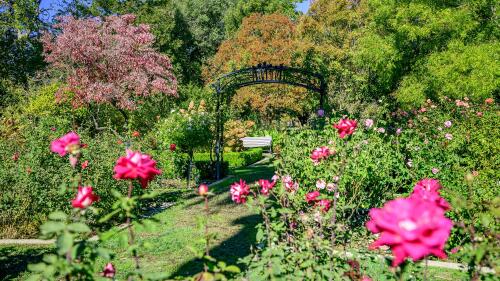Bridging the gap between Sacramento + West Sacramento, truss us when we say the 160-ft tall Tower Bridge is more than an iconic landmark — it’s an architectural delight with a backstory that tells us about the development of the River City. Let’s connect the dots.
Railcars, trains, and automobiles
In the 1910s, Sacramento was mainly accessible by boats, passenger trains + freight railcars, which was reflected in the city’s infrastructure.
Take the M Street Bridge as an example: Erected in 1911 by the Sacramento Northern Railway in the spot where the Tower Bridge stands today, it accommodated the heavy demands of both river and railroad transportation. Oh, and vehicles — but on a single 9-ft wide lane that was one of the major links along US Highway 40.
By the 1930s, residents + city leaders began to realize that the bridge — which utilized a swing bridge design — was no longer functional for the city’s transportation needs. Chief among the critics was the Sacramento Chamber of Commerce, which voiced concern that the M Street bridge was hazardous to motorists with its modest-at-best traffic lane.
Let’s put that concern in a bigger context — by the time 1934 had hit, not only did automobile traffic across the bridge rise by 700%, the city went from 45,000 residents to 100,000. In other words, one lane each way for automobile traffic just wouldn’t cut it for the growing metropolis, and it was an easy decision for the city to declare the bridge obsolete.

An early sketch of Tower Bridge | Image courtesy of California State Archives
Motoring out of the past
In early 1934, the San Francisco-based but Missouri-born architect Alfred Eicher — as a California state employee — began work on a new design that would replace the M Street Bridge.
Alfred spent several months sketching and refining the elements of the project. Eventually, he landed on the idea that featured a vertical lift design to increase the width of the channel + decrease delays with an adjustable span that could be “raised or lowered at a rate of one foot per second.”
Construction began on July 20, 1934 when crews built “new main piers” for the bridge. Once that was completed, a temporary timber-and-steel bridge for railroad traffic — aka a shoofly — was built, and all highway traffic was sent upriver to the I Street Bridge. With all this out of the way, the team managed to dismantle the old, obsolete bridge by March 11, 1935.
Work on the new bridge itself started in earnest just four days later on March 15, 1935 — a task large enough to require the creation of 1,500 new jobs during a time when the nation was straddled with massive unemployment as an effect of the Great Depression. In fact, ~130 laborers could be found working at the site at any given time.

A perspective sketch of Tower Bridge by Alfred Eichner | Image courtesy of California State Archives
A new (over)watermark
Just nine months later, Governor Frank Merriam dedicated the Tower Bridge as the first vertical lift bridge in California’s highway system at a ceremony on M Street on Dec. 15, 1935. The total cost of the project was $994,000, which is ~$23,203,000 million in today’s money.
The Tower Bridge was initially a silver color until it was repainted a brassy hue in 1976 to match the color of the State Capitol’s copper dome. In 2002, the bridge was painted metallic gold after winning a public vote by Caltrans for residents within a 35-mile radius.
Symbolizing a change of the times, the railroad tracks were removed in 1963, meaning the bridge only allowed vehicular + pedestrian lanes. By 1980, it was entered into the National Register of Historic Places.
The Library of Congress has this note on one of the images it has archived: “The bridge represents a rare use of Streamlined Moderne architectural styling in a lift bridge, making it an outstanding expression of the social and architectural climate of the period.”
Next time you pass Tower Bridge on the highway or admire its view from the docks of Old Sacramento, take a moment to appreciate the work our city did to get to where we are today— or simply geek out at the fact that it’s home to California’s shortest state route.











